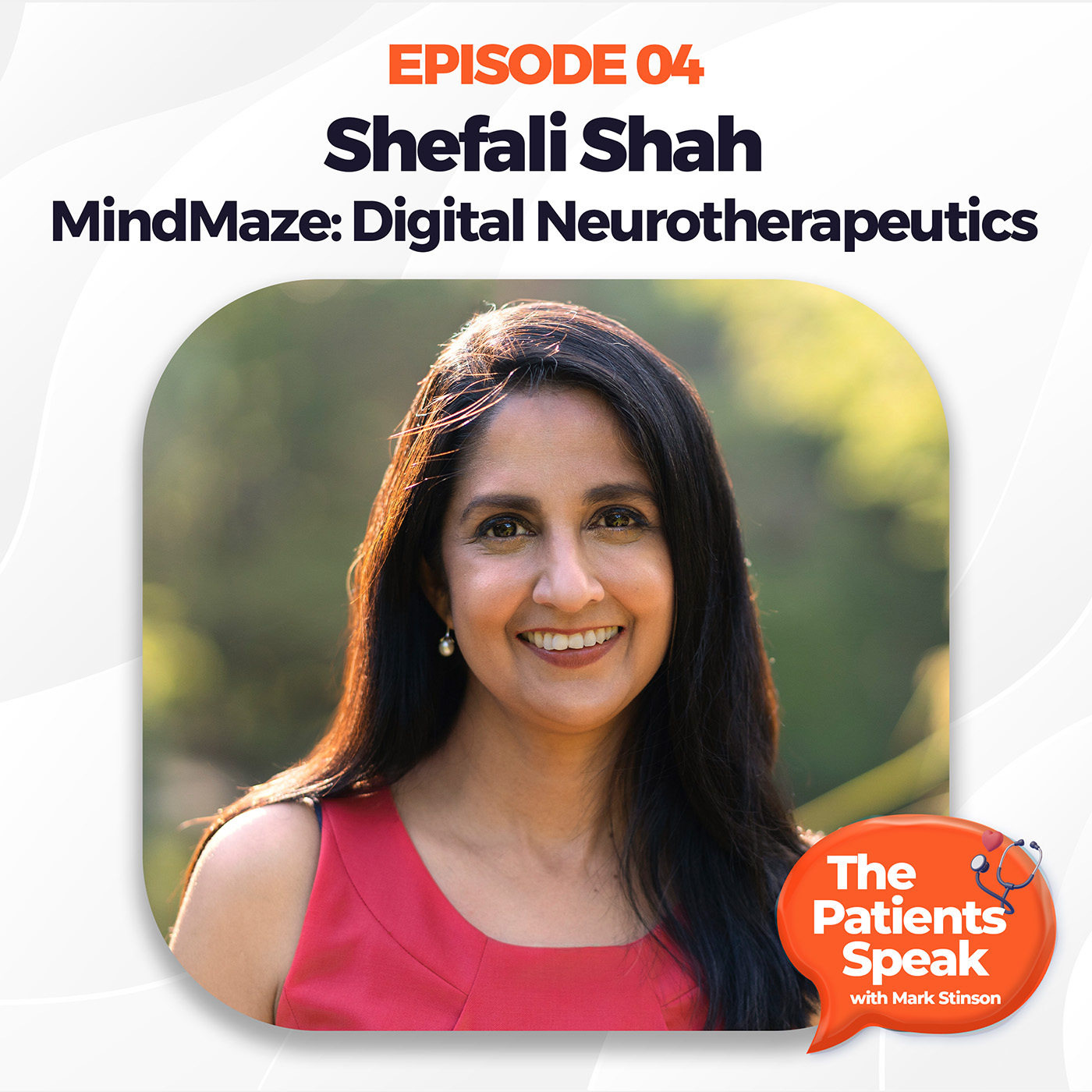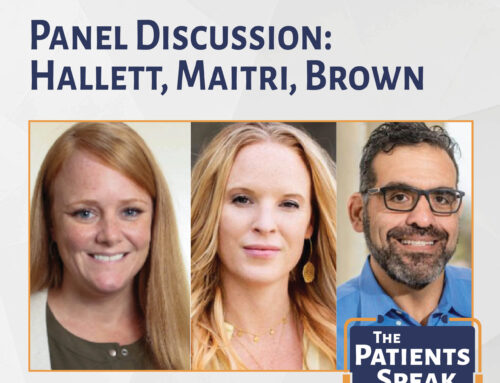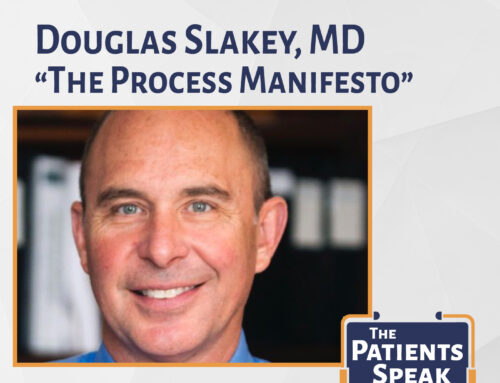Welcome friends, to our new podcast, The Patients Speak, where we combine the business and science innovations in healthcare with the patient voice, the patient experience, and activating patients to be more involved and more empowered in their own healthcare.
Today’s guest is Shefali Shah, she’s global VP of market access and commercial effectiveness for a company called MindMaze, a brain technology and neurorecovery company. She is an expert in evidence-based strategies for digital healthcare. Her background includes market access for pharmas, including GSK, Novo Nordisk, and InVentiv Health (now Syneos)
Mark Stinson, host:
Welcome friends, to our new podcast, The Patients Speak, where we’re going to combine the business and science innovations in healthcare with the patient voice, the patient experience, and activating patients to be more involved and more empowered in their own healthcare. It’s an exciting time in our industry, and we want to bring the experts to understand how to bring in patients more effectively. And today’s guest is Shefali Shah, she’s global VP of market access and commercial effectiveness for a company called MindMaze, a brain technology and neurorecovery company. She’s also an expert in evidence-based strategies for digital healthcare. And her background includes market access for pharmas, including GSK and Novo Nordisk, and also in Inventiv Health. Shefali, welcome to the program.
Shefali Shah, guest:
Well, thank you, Mark. Nice to see you.
Mark Stinson, host:
We’ve got to start with this idea of digital healthcare, specifically digital therapeutics that you’re involved in. Help us define that term in terms of not only the technology in the category, but maybe even the FDA and regulatory definition of what a digital therapeutic is.
Shefali Shah, guest:
Sure, Mark. So this is a definition that is evolving, but there are organizations, like the DTA, that have a fairly good framework for us to define a digital therapeutic. And the way they define it is really evidence-based therapeutic or an intervention that uses software to manage or prevent a disease. And I like that definition as a starting point. Of course, where MindMaze is going is really combining a lot of different modalities to create an immersive experience for the patient. So it is not just about the software, it is also about integrating the therapist, the care team, the hardware. So in some ways we are a little bit different, we are taking that definition to the next level.
Mark Stinson, host:
Well, and some people think about the digital applications, there’s a lot of apps out there that might track or give you a diary or gamify your medication, but it seems like this digital neurotherapeutics that MindMaze is working on seems to go beyond that.
Shefali Shah, guest:
Absolutely. As you know, different people respond to different modalities of learning. And when you’re creating a medicine to help patients who have had sudden onset neurological disorders like a stroke or a traumatic brain injury, or you’re looking at patients who have degenerative neuro disorders, like Parkinson’s, either way the patients are going to learn differently and are going to need a lot of different modalities to overcome some of the challenges and continue to thrive. It does require a lot more than a game. So yes, the games are very, very important, because you can vary the games, that is the basis of our platform, but then there is also so much more.
Mark Stinson, host:
Mm-hmm. Well, it’s exciting technology. Thinking about now our topic of patient voice, how does your company build into the system incorporating the patient’s voice?
Shefali Shah, guest:
Yes, that is so critical. And we really live the patient journey in a number of different ways. First and foremost, we have beyond the product team, patients who have survived stroke or other traumatic brain injuries, they are in there developing the product. So right from the very base, we have patients bringing in their experience into the fabric of the product. The other thing is, also bringing therapists into the product-design process. These are therapists who have seen hundreds and thousands of patients across their lifetime, and they understand at a more macro level what are some of the commonalities and what are some of the biggest challenges that patients face, even though, as you know, every patient is going to present themselves quite differently, but yet there are some universal factors that we are able to take into consideration.
And we do so much more, we are looking at patient research. I personally listen to podcasts to really understand the patient journey. I do have to give a shout out to a podcast called Recovery After Stroke. They have done an amazing job of just talking to patients and caregivers. And I think listening to those stories unfiltered, without saying, “Hey, this is for market research purposes,” is such a fantastic way of integrating their experiences into our product.
Mark Stinson, host:
That’s so interesting, the unfiltered idea. I mean, obviously you have to translate it to what you’re working on, but yeah, literally from the patient.
Shefali Shah, guest:
Yes, exactly. I mean, they put their stories out there for people to listen. So of course we respect and we take that in, just really learn from it.
Mark Stinson, host:
Let’s drill down a little bit to maybe clinical trial design, clinical trial recruitment, to make sure you get those real-world experiences, not just the perfect patient in a clinic.
Shefali Shah, guest:
Yeah. The clinical trial design is such an interesting topic as well. Now, while I’m on the commercial side, and the clinical trial team is focused on developing scientific evidence, we want to make sure that when we run the trials, they are in a setting that is very real to the patients. So patients who start out in the ER, for instance, are then moving into more intensive rehab or a skilled nursing facility, and then are moving into outpatient care, and eventually going home. The treatment and therapy and the medicines they need across each of these stages is very different. Connecting that patient journey, especially in the US where it is such a fragmented healthcare system, across all of these different sites of care is very complicated, but we don’t want to ignore the fact that this occurs for the patient journey. And so as we design the clinical trials, we take very real-world experiences of connecting the inpatient and the outpatient and the home-care settings and stringing all of those in designing the trials.
Mark Stinson, host:
Well, and you mentioned your role in commercialization, but to ultimately provide the market access-
Shefali Shah, guest:
Yes.
Mark Stinson, host:
… so patients can access this digital therapeutic is really, there’s a lot in common with market access for a drug, but what are some of the challenges you’re envisioning in bringing products like this to the market?
Shefali Shah, guest:
It’s such a good question. So my job, as you know, has market access, which is ensuring access to patients, but the commercial-effectiveness side is all about gathering data and insights to support those decisions. So for me, the market access challenges are really around the different reimbursement pathways that have been designed for the different sites of care. Now we’re looking at part A, part B, part C and part D. And all of these sites of care have such different reimbursement schemes. One is capitated on part patient. The other is fee for service. And then the third doesn’t fully exist yet. So to string all of that together in real world is a little complicated, but we know our patients need it. If it’s complicated for us as a company, I can only imagine how hard it is for a patient and their caregivers to navigate this. And that’s what drives us. So it is our biggest challenge, but it drives us as a company, and me personally, to make things better for patients.
Mark Stinson, host:
So many times we talk about the patient journey, and we forget about anything but the medical part, but the payer, the diagnostic code, it doesn’t exist if it doesn’t have a diagnostic code, a CPT or anything else, because if they can’t get paid for it-
Shefali Shah, guest:
Yeah.
Mark Stinson, host:
Well, can you think of a time when the real patient voice and their experience impacted or changed the direction beyond just an emotional, “Boy, that was really a great story,” but I mean, it moved you to a different action step?
Shefali Shah, guest:
That’s an important question. What has impacted me is listening to patient stories and patient journeys. As I was listening, I noticed a pattern, and I noticed this pattern only among the US patients. They were talking very bravely about their clinical journey, and how they got a lot of help along the way from different physicians, clinicians, therapists, caregivers. And sometimes they had to overcome challenges. Overall, they were very motivated to heal themselves, to get back to normal life. And they spoke with an attitude of hope and grit. When it came to cost of care, all of them had a low point at some point within their journey, whether they almost lost their house, or their caregivers left them because they could not afford a nurse to come in, and they were just tired of taking care of the patient themselves, or that insurance just stopped covering because they went from one set of care to another.
And that really struck me as an important piece that we need to solve for. What that meant to us, from a business decision, is to have therapy integration managers that took the patient from site of care to site of care, and was there to help with the cost aspect. And have we solved for all of that yet? No.
Mark Stinson, host:
Well, there’s no perfect solution, but even the title of that individual, the scope of that role, a therapeutic integration manager, yeah, it sounds so good-
Shefali Shah, guest:
Yes.
Mark Stinson, host:
… this concierge, “Let me guide you from care point to care point.”
Shefali Shah, guest:
Exactly. And I think that’s what our patients deserve. Why should they have a low point when it comes to cost, when they’re working with such grit, and yet what breaks them is the cost, does that sound fair? No.
Mark Stinson, host:
Not at all. Well, my guess is Shefali Shah, Global VP of Market Access and Commercial Effectiveness at MindMaze. Shefali, thinking about all that it’s going to take to bring this category to life, digital therapeutics, and then specifically in your category, digital neurotherapeutics, what kind of collaborators or other industry leaders or other patient groups are you looking to team up with to really elevate the status of this category?
Shefali Shah, guest:
Yeah, absolutely. I mean, partnerships are going to be critical. Having the support of APTA and the AAN societies, the clinical societies, but also the patient advocacy groups, is absolutely critical, because they have the scale and the negotiating power. We are a small company, and without their support and making sure that we are actually solving the problems and the challenges of their members is going to be really important. And so we are going to be actively outreaching to all of these organizations. And so as a result of this podcast, if any of these organizations want to reach out to us, that’s great, because I think that there is common ground and common objectives to help our patients.
Mark Stinson, host:
Well, I think that overall in our healthcare industry, across pharma, biotech, now digital therapeutics and devices and diagnostics, there’s no one answer. And so to the extent we can connect some dots, we do imagine some of those people might be listening.
Shefali Shah, guest:
Thank you. Thanks for this opportunity for people to reach out to us.
Mark Stinson, host:
Well, Shefali, before we close, I thought we’d take a 50,000-foot view of our conversation. How would you give a summary, some of the points we’ve been talking about?
Shefali Shah, guest:
What you are really trying to do is, trying to figure out what patients are experiencing and how our company’s helping. And what excites me about the journey at my MindMaze and what we are doing is you are helping us focus on the entire patient journey. We at MindMaze, we are not just solving for one aspect of the patient journey, but really across the board. Now, our solutions are more focused on motor functions right now, but we are also going into cognitive and behavioral aspects later, that this concept of focusing on the entire patient journey and being that partner in that journey is such an important piece. That is what excites me.
Mark Stinson, host:
Mm-hmm. Yeah, that’s very motivating. Well, thanks for being on the show, Shefali, really appreciate you bringing your experience, your insight and your vision to our podcast.
Shefali Shah, guest:
Well, thank you for having me, this is fantastic.
Mark Stinson, host:
Well, my guest has been Shefali Shah, she’s global vice president of market access and commercial effectiveness for MindMaze, a brain technology and neurorecovery company. Listeners, we thank you for coming by. If you’re one of the early listeners to our podcast, we appreciate you listening and subscribing. And more importantly, if you have feedback, comments, guest recommendations, we’d love to connect and share our vision of listening better to the patient, and accelerating the patient journey, how do we get faster at identifying and educating and bringing new therapeutics to the patients? And that’s our mission on this podcast. And we thank 83bar for producing and sponsoring the show. I’m Mark Stinson. Come back again next time when I interview another healthcare innovator, and what they hear when they listen to The Patients Speak.





